#Shenzhou 12
Text
A Whovian Watches Star Trek for the First Time: Part 107 - The Emperor's Palace-Ship
Star Trek: Discovery - Season 1 Episode 12 - Vaulting Ambition
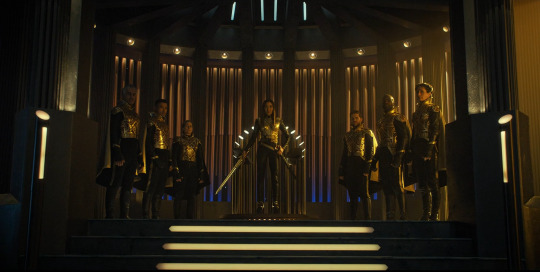
We open with Michael and Lorca being shuttled over to Emperor Georgiou. Unfortunately, the Shenzhou's information on the Defiant is heavily redacted, but it's likely that the full information is in the Imperial Palace, a ship called the Charon. I love the Charon's design, I love the scale of it, and how beautiful it is. Also, apparently Michael was raised by Emperor Georgiou, which makes sense given that she couldn't have been raised by Sarek here, and how Georgiou was her main mentor in Starfleet
Meanwhile on Discovery, Sylvia is resuming her treatment of Paul, who is once again interacting with his Empire Counterpart in the spore network. The Interactions with his other self are really fun, and the wild dreamscape of the spore network made for some nice visuals. Weird fucky dreamscapes are always fun, and this served a pretty good farewell between Paul and Dr Culbur. Our Paul however, wakes up at the same time as the other Paul. Unfortunately, the Empire's Paul has been doing his own experiments on the Spore Network, except he's actively killing it.
I wasn't to sure about Georgiou as the Emperor last episode, but her actress really sells it here. There is definitely a really creepy vibe in her dinner scene with Michael, where we also find out Kelpians are considered a delicacy in the Empire's Universe. That certainly brings a new layer to Saru's personal curiosity asking about them a while back. The scene really highlights the constant paranoia of this universe, with Georgiou being perfectly willing to execute her daughter on the mere suspicion of a plot to overthrow her.
Michael plays a really interesting gamble over telling Georgiou about the whole parallel universe situation, and uses Our Georgiou's rank badge as proof. This results in the immediate execution of everyone in the room except Georgiou, Michael and one shocked terrified assistant, which actually got a giggle out of me.
As all of this is going on, Ash is currently physically tearing himself apart over the conflict between the Human and Klingon parts of his Psyche. Discovery's Doctors do not know what to do with him, so we get a few scenes of Saru pleading with the Klingon Torturer to help, as she is the only one who understands the process that did this to him. At first she is reluctant, but after seeing the suffering in person, she finally admits there is one way to undo it. She begins the procedure, under armed watch
Apparently the way the Defiant moved between universes drove the entire crew mad to the point where they all killed eachother, meaning as a way back it's useless. Michael and the Emperor come to an uneasy bargain that she can go free in exchange for the schematics for Discovery's Spore Engine. No amount of negotiation however can convince the Emperor to let Lorca go.
In a scene where Lorca is being tortured, we get to see another absolutely brutal method that the Terran Empire has to execute people, as Lorca's loyalists are executed in front of him, the first one being an injection that burns away then explodes the victim.
Our final cliffhanger for the episode is the reveal that our Lorca and the Empire's Lorca are in fact one and the same, a twist I really didn't see coming, but kinda felt like it came a bit out of nowhere. We get flashbacks to certain "hints", but really they're just random details. I'm still interested to see where this goes though. It was an alright episode, with some great moments, but I wish we could do a bit more world. Maybe with a bit of fleshing out beyond this twist for me to accept it, but this definitely made Lorca a much less fascinating character for me, but we'll see if he can recapture it.
#whovian watching star trek#star trek#star trek Discovery#Star Trek DIS#Star Trek DISCO#ST DIS#ST DISCO#DIS#st: disco#DISCO#st: discovery#Discovery#ST: DIS
13 notes
·
View notes
Text
Best of Discovery Season 1
This year the final season of Star Trek Discovery airs, bringing an end to the show that brought Star trek back to television after over a decade absense. To celebrate its 5 season run (which was incredibly long for a streaming show, I'll be doing a best of for all the seasons of streaming era trek so far, listing great moments/scenes (at least 13, as this was meant to be a bakers dozen series), and One honorable mention.

To start off, the season that Started it all, Star Trek Discovery Season One . Spoilers below
Battle of the Binary Stars

A fleet of Starfleet ships arrive to back up the USS Shenzhou against a klingon fleet, and what a fleet it is. A whole era of Starfleet design is explored in a single scene against a goreous backdrop of the titular binary stars.
2. U.S.S. Europa arrives
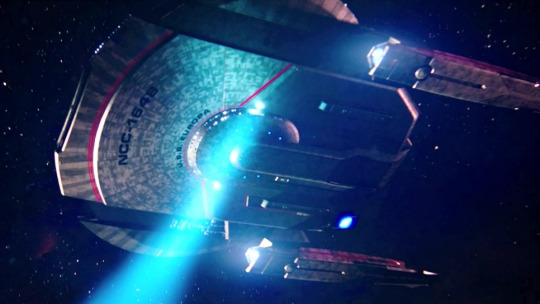
The U.S.S. Shenzhou is disable by the battle and is drifting towards an astroid when the Admiral's Flagship arrives. The Nimitz Class U.S.S. Europa arrives at the last second, tractoring the Shenzhou and calling a temporary ceasefire to the battle. It is a visually gorgeous scene with a wonderful score. For just a moment, the arrival of the mighty starship make it seem like everything might be okay.
3. U.S.S. Discovery arrives
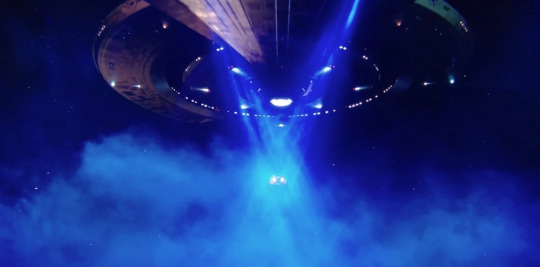
U.S.S. Discovery, the namesake off the show doesn't appear till episode 3, but she make a grand entrance, saving the prison shuttle transporting Burnham in a scene that wonderfully conveys her size and grandeur
4. The shushing Klingon
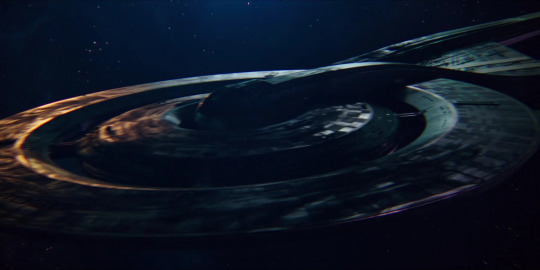
Aboard the damaged U.S.S. Glenn, a team from the U.S.S. Discovery find the crew fataly mutilated by a failed spore jump, but more immediatly threatening, a monster roams the halls of the stricken ship, one capable of killing the klingon boarding party sent to recover the ships secerts. The scenes onboard the Glenn are brutal, and wonderfully tense. It also gives us the hilarious "did that klingon just shush me?" Moment. (I chose a pic of the Glenn rather than the interior as those were more graphic than I wanted for this post)
5. The Discovery saves Corvan II
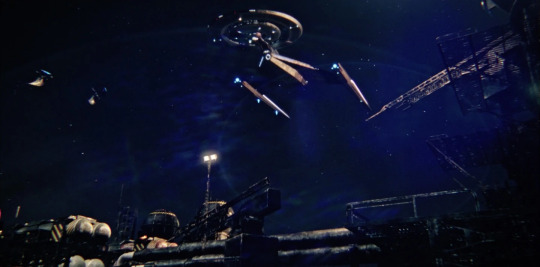
Discovery makes her first successful long range spore jump and saves the Federation mining Colony Corvan II. Its a wonderful moment od Discovery's crew coming together to save civilians.
6. Please Don't Take My Ship, She's All I Have Left

This moment between Cornwall and Lorca is amazing, and makes me wish that lorca hadn't been mirror Lorca. His plea for him to keep command off discovery is heartfelt (but later revealed to be for all the wrong reasons)
7. Mudd Loses

Magic to Make the Sanest Man go man is amazing throughout, but the moment the crew finally outwits Mudd is so, so satisfying.
8. The Loss of the USS Gagarin
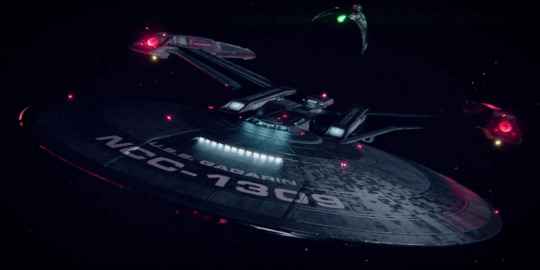
The Discovery attempts to save the U.S.S. Gagarin from the Klingopns and fails, despite their best efforts. The loss makes the war feel far more real, and highlights the fact the Discovery is just one ship, no matter her spore drive. I also love Lorca's speech here-"There will be time to grieve later"
9.Destruction of the Sarcophagus ship

A satisfying victory for the crew, and seeing discovery make all the jumps is an epic scene.
10.Mirror Tilly...kinda

"If you spoke to me that way I would cut out your tongue to lick my boots" What a line. Tilly taking on the role of her mirror counter part is amazing.
11. I.S.S. Shenzhou

The Mirror Shenzhou arrives, and she is beautiful. A former hero ships twisted mirror half.
12. Burnham kills Captain Connor

an amazing fight, and what a gut punch, as Burnham is forced to watch Connor die again, this time by her own hand. The crew clapping after the turbolift opens and his body falls out is chilling in the best way.
13. Reveal of the Imperial Palace

The I.S.S. Charon is an intimidating presense, and way cooler than a palace on a planet.
14. Destruction of the Charon and Discovery jumps Home
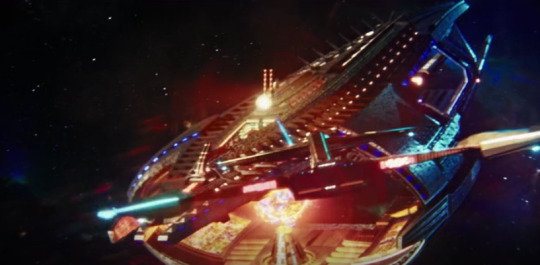
The bombing run Discovery makes on the Charon and her jump back to the prime universe using the resulting show wave is awesome, made even better on a personal layer by Burnham saving Mirror Georgiou-"I couldn't watch her die again"
15. Arrival at Qo'noS
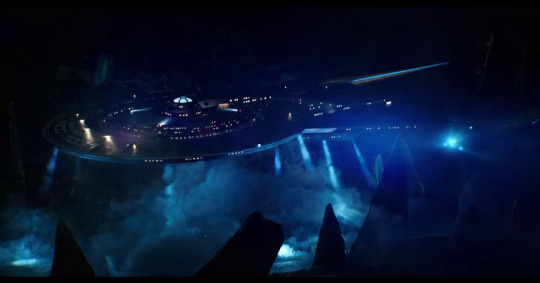
Discovery jumps to a cave on Qo'nos, and I love the weight of the scene. You can feel gravity grabbing the ship and Discovery struggling against it.
16. We are Starfleet

The scene the show has been building to, Burnham stands up to command over the plan to destroy the Klingon homeworld, and the crew backs her up.
17. U.S.S. Enterprise
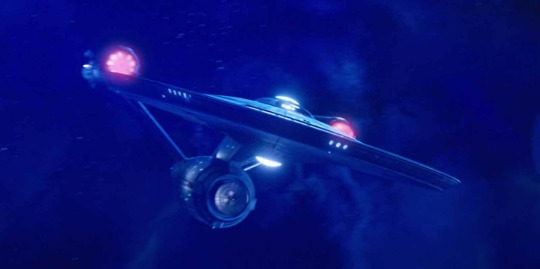
I remeber when I first saw her. The 1701 returned in all her glory. The TOS version is the definative U.S.S. Enterpise to me, but Discovery gave us an amazing earlier version. It had been decades since the prime 1701 had appeared on screen (we don't count certain series finalies) and its honestly still my favorite moment of the season.
Honorable mention: U.S.S. Discovery

the original teaser for the show showed a much different Discovery. While I understand this was never meant to be the final, I lover her all the same. It was also the moment Trek was back, after decades we had a new hero ship. I hope STO adds her someday, and that someone makes a model of her. She may not be the offical version, but she deserves love all the same.
#star trek#star trek discovery#star trek discovery appreciation post#USS Discovery#USS Enterprise#I don't own any of the screencaps#obviously
6 notes
·
View notes
Text
14 chinos regresan a la Tierra desde la estación espacial Tiangong
Los 14 astronautas de Shenzhou de China entregaron el control de la estación espacial Tiangong y regresaron a la Tierra.... https://skycr.org/2022/12/04/14-chinos-regresan-a-la-tierra-desde-la-estacion-espacial-tiangong/
Los 14 astronautas de Shenzhou de China entregaron el control de la estación espacial Tiangong y regresaron a la Tierra.
La cápsula de regreso de la nave espacial Shenzhou de la misión aterrizó de forma segura después de la puesta del sol en el área de aterrizaje de Dongfeng en el desierto de Gobi en la Región Autónoma de Mongolia Interior el domingo (4 de diciembre) alrededor de las 7 a.m. EST…

View On WordPress
2 notes
·
View notes
Text
Star Trek: Eagle
NX-Class Ships of the War
NX-01 Enterprise: Launched in 2151 under the command of Captain Jonathan Archer, the Enterprise was the pride of Starfleet and one of the most important ships in the war.
NX-02 Columbia: Commanded by Captain Erika Hernandez and launched in 2154, the Columbia operated until 2156, when it was destroyed in the Battle of Algeron.
NX-03 Challenger: Launched in 2154 under the command of Captain Jeanette Gautier. Her mission took her to the borders of the Cardassian Union, where she laid the foundations for future cooperation between the First Republic and United Earth in the 23rd century.
NX-04 Discovery: Launched alongside the NX-03, Discovery was assigned to explore a region of space coreward of the Sol System, making first contact with the Saurian species and making formal contact with the Deltans. Under the command of Tomas Zamora, Discovery was instrumental in the Kzinti Campaign of the Earth-Romulan War.
NX-05 Atlantis: One of four NX-class vessels that were built as part of an accelerated shipbuilding campaign in the wake of the Romulan Crisis and launched in early and mid-2155 alongside the NX-06 Endeavor, NX-07 Apollo, and NX-08 Eagle. Under the command of Captain Brendan Harrington, it was assigned to deep space exploration before being recalled at the start of the Earth-Romulan War.
NX-06 Endeavor: Following the conclusion of the Xindi Crisis, the NX-06 Endeavor was assigned to explore the former Delphic Expanse. Under the command of Captain Hanabi Ozawa, Endeavor made contact with over a dozen species.
NX-07 Apollo: Commanded by Captain James Chen, the Apollo was originally assigned to explore planets just short of the Klingon border, but was quickly recalled at the beginning of the Earth-Romulan War.
NX-08 Eagle: Launched in mid-2155, the Eagle is considered the last of the "pre-war" NX-class spaceframes. Her original mission was to explore the region of space just beyond Mu Capricorni, but was recalled a few months later.
NX-09 Mercury: The first of the "war-era" NX spaceframes. Commanded by Captain Charles Collie, the Mercury was immediately sent to the frontlines near Bolarus.
NX-10 Vostok: The sister ship of the NX-09, the Vostok was launched under the command of Captain Timothy Bereza and assigned to Defense Group B, intercepting dozens of Romulan warships attempting to penetrate the defensive line.
NX-11 Gemini: Launched in July of 2157, the Gemini was under the command of Captain Samantha Clark, a descendant of the famous William Clark, and assigned to push the frontlines as far coreward as possible.
NX-12 Voskhod: Launched alongside the NX-11, the Voskhod, under the command of Michelangelo Ramirez, was assigned to Defense Group A, protecting the region coreward of the Sol System.
NX-13 Orion: The first of the last block of NX spaceframes ever built, launched in 2158 under the command of Captain Masaharu Sulu. The Orion, along with her sister ships, the NX-14 Orel, NX-15 Shenzhou, and NX-16 Gaganyaan, were launched weeks ahead of schedule during the Battle of Proxima Centauri.
NX-14 Orel: Launched ahead of schedule in 2158 under the command of Captain Albert MacKay, the Orel was destroyed in the Battle of Proxima Centauri.
NX-15 Shenzhou: Launched in 2158 to take part in the Battle of Proxima Centauri, the Shenzhou was lost along with her captain, Thomas Lau.
NX-16 Gaganyaan: Launched alongside the NX-13, NX-14, and NX-15, the Gaganyaan fought in the Battle of Proxima Centauri under the command of Captain Roy Khurana. It, along with the Orion, survived the battle and the lessons learned formed the basis of the major refit for the NX spaceframes in 2161.
3 notes
·
View notes
Link
During the last full week of April, forthcoming launches include two Starlink missions planned on Monday and Friday, and another two more Falcon 9 flights lifting customer satellites. The first of these is the delayed WorldView Legion 1 & 2 mission which was originally due to fly last week and is now scheduled for Wednesday. The first Starlink mission of the week will also see another milestone reached with the 300th landing of a Falcon 9 booster on the Group 6-53 mission. The fifth Electron to launch this year will carry two demonstration missions into two notably different orbits on Wednesday. One of the two demonstrations being hoisted by Rocket Lab is a demonstration of a novel solar sail developed by NASA and powered by the pressure of sunlight acting upon the surface of the sail. The week will also deliver a crewed launch on Thursday when the Shenzhou 18 mission sends three more taikonauts to the Tianhe core module of China’s Tiangong space station. The number 13 resonates this week, with Shenzhou 18 being the 13th crewed mission of the Chinese space program, and Falcon 9 looking on course to repeat its current record of 13 flights in a month. This is reliant on the Galileo satellite mission, which has not yet been given a firm launch time and is currently scheduled to fly no earlier than Sunday, April 28. B1060 will be making its 20th and final flight and was the first booster to be recovered 13 times back in June 2022. This will be the first time a Falcon 9 single first stage has been expended since November 2022. Assuming the Galileo mission does launch this week, it will be the 82nd orbital launch of the year. This is 18 more than the count on the equivalent date last year, and largely due to SpaceX’s remarkable Falcon 9 launch cadence. Coincidentally 13 years ago this week Shuttle Endeavour was also ready on the pad for its final mission (STS-134), and the penultimate one for the Shuttle program. A malfunction on one of the auxiliary power units caused the launch to be scrubbed and delayed into May, however. This time last year there had also been the same number of Starship launches for the year so far — it’s been over a year now since Starship’s maiden flight back on April 20, 2023, on the IFT-1 mission. It is also ten years this week since the company achieved the first successful propulsive ocean touchdown of a liquid rocket engine orbital booster on the CRS-3 mission and the first Falcon 9 which flew with landing legs. Booster B1076-12 landed on droneship Just Read the Instructions, during the Eutelsat 36D mission in March 2024. (Credit: SpaceX) Falcon 9 Block 5 | Starlink Group 6-53 The first Starlink mission of the week is scheduled to launch from SLC-40 at the Cape Canaveral Space Force Station on Monday, April 22 at 6:40 PM EDT (22:40 UTC). The payload is another batch of 23 Starlink v2 Mini satellites massing around 16,800 kilograms and heading into an initial 285 by 293-kilometer orbit, inclined by 43 degrees. The booster for this mission has not yet been declared but is expected to land on the autonomous droneship Just Read the Instructions around 604 kilometers further downrange, while support ship Bob will recover the fairings. Significantly this will be the 300th landing of a Falcon 9 booster, and the 226th since the last unsuccessful one. These Group 6 missions continue, at least for the time being, to launch in numerical order except the missing Group 6-50 mission which remains unscheduled at present. This will be the 158th launch dedicated to Starlink overall and the 84th for the Gen2 series. SpaceX has successfully launched 24 Starlink satellites in a single batch in the past and has declared a desire to extend this number further to 28 in a single batch by the end of the year. Starlink launches from the east coast are expected to focus on this pad soon while LC-39A is prepared for the GOES-U launch on Falcon Heavy in June. As the week begins and before this flight, SpaceX has launched a total of 6,258 Starlink satellites, of which 406 have re-entered and 5,206 have moved into their operational orbit. Electron is prepared at LC-1 in Mahia Peninsula. (Credit: Rocket Lab) Electron / Curie | Beginning of the Swarm Rocket Lab is due to launch the fifth Electon of the year and its 47th mission overall on Wednesday, April 24 for the Beginning of the Swarm mission. Lift-off is scheduled at the start of an 85-minute window at 09:30 NZST (21:30 UTC on the 23rd) from pad LC-1B in the Mahia Peninsula of New Zealand. Two different payloads are sharing a ride for this mission. Firstly, NeonSat-1 is a demonstration mission ahead of the planned constellation of high-resolution optical satellites which would begin to launch from 2026 onward. The satellite was developed by the Korea Advanced Institute of Science and Technology and its Satellite Technology Research Center which launched Korea’s first satellite (KITSAT-1) 32 years ago. This Earth observation satellite will monitor natural disasters along the Korean peninsula, applying artificial intelligence to its high-resolution imagery. It will be deployed 50 minutes into the mission into a circular orbit at 520 kilometers in altitude. Electron’s Kick Stage will then light its Curie engine to raise its altitude to 1,000 kilometers, with a second burn to then circularize the orbit where it will deploy a second payload one hour and 45 minutes into the mission. Render of NASA’s ACS3 Solar Sail in orbit. (Credit: NASA) This is another technology demonstration, developed by NASA’s Ames and Langley Research Centers. This Advanced Composite Solar Sail System (or ACS3) technology demonstration will deploy a solar sail from a cubesat using lightweight booms made from composite materials. As the name implies, this sail will leverage light from the sun and will be propelled by the pressure of sunlight acting upon it. The spacecraft will spend a couple of months in an initial flight and checkout phase before deployment of the booms and reflective sail. The craft needs to be at a sufficient altitude for the tiny force of sunlight that will be applied to the sail to overcome atmospheric drag. At this altitude, this force is said to be roughly equivalent to the weight of a paperclip resting on your palm. The craft will then perform a series of pointing maneuvers to demonstrate orbit raising and lowering which will span weeks, so it could be July or later before any results are known. It is intended that the data from this mission informs the creation of larger solar sails that could efficiently propel satellites for several usages such as communications relays on future crewed exploration missions, early warning satellites, or reconnaissance missions such as to near-Earth asteroids. Reducing mass could help to eliminate heavy propulsion systems and make longer-duration missions more efficient in both energy and cost. The kick stage will fire its engine retrograde one final time to lower its orbit, enabling atmospheric drag to eventually complete the task of deorbiting it, where it will burn up on re-entry. This mission required the addition of extra propellant tanks, extra batteries, and larger gas bottles for the reaction control system on the kick stage. Rocket Lab is moving closer toward the reuse of a recovered Electron first stage. The company announced in early April that the carbon composite first-stage Electron recovered from the Four of a Kind mission in January has entered the production line for final acceptance testing and qualification ahead of a reflight. Encapsulation complete for our 47th mission! NEONSAT-1 (@KAISTPR) and ACS3 (@NASA) are now safely enclosed within Electron’s fairing. The next time this nose cone opens up, these two satellites will be in space! ‘Beginning Of The Swarm’ Mission info: https://t.co/xyg2Ghty8K pic.twitter.com/i25zKlUqNs — Rocket Lab (@RocketLab) April 18, 2024 Falcon 9 Block 5 | WorldView Legion 1 & 2 A Falcon 9 was originally scheduled to launch from SLC-4E at Vandenberg Space Force Base last week on April 17, carrying two satellites massing a total of 1,500 kilograms into a Sun-synchronous orbit. This flight was postponed the day before launch, however, and is now scheduled for this Wednesday, April 24 at the start of a four-and-a-half-hour window at 11:30 AM PDT (18:30 UTC). The booster, which has yet to be confirmed, is expected to return to land on the pad at Landing Zone 4 located around 400 meters away from the launch mount. The WorldView Legion satellite constellation is Maxar Technologies’ next-generation constellation of Earth observation satellites, designed and built in-house at the company’s facilities in Palo Alto and San Jose, California. DigitalGlobe, which was later taken over by Maxar, first announced its selection of SpaceX as the launch provider back in 2018 when the satellites were initially anticipated to launch in two blocks of six. Hardware-based delays, as well as the complexity of the technology, have caused several setbacks. The planned constellation will now consist of six satellites in total, to be launched in pairs and will orbit in polar and mid-inclination orbits. The satellites are the first to utilize a new Maxar 500 series bus platform with better stability, agility, and pointing accuracy. They will occupy an approximately 500-kilometer altitude orbit when fully deployed, providing 30-centimeter high-resolution imagery and eight-band multispectral imagery across 15 revisits per day over the most active regions of the world. The satellites will triple the company’s coverage in 30-centimeter class resolution, capturing five million square kilometers of imagery each day. The satellites are designed with a 10-year lifespan. With @RTX_News, we developed a new telescope for the WorldView Legion satellites. They collect the high-quality images that customers have come to expect from us, but the telescope is smaller and requires less power.More details: https://t.co/PKttctsC39#ittakesalegion — Maxar Technologies (@Maxar) April 11, 2024 Applications will include supporting national security missions for monitoring and surveillance of ground-based potential threats or verifying enforced sanctions and treaties. The satellites also provide a variety of maritime monitoring functions such as the surveillance of natural disasters, pollution, and oil spills through to the detection of illegal fishing, piracy, drug smuggling, or human trafficking. Utilizing artificial intelligence algorithms, the WorldView Legion satellites can support the ability to detect, identify, and respond quickly to suspicious activities. Maxar worked with its instrument partner Raytheon to develop a smaller telescope that requires less power. Chang Zheng 2F/G | Shenzhou 18 China is sending three more taikonauts from the People’s Liberation Army Astronaut Corps to the Tianhe core module of China’s Tiangong space station on Thursday, April 25. Lift-off is expected near the start of a 40-minute launch window at 12:59 UTC from Site 901 (SLS-1) at the Jiuquan Satellite Launch Center. The crew is expected to arrive at the space station around seven hours later. Shenzhou 18 will be the 18th mission of the Shenzhou (“divine craft”) program and the 13th of these to be crewed. As with other missions in this series, the vehicle will be the Chang Zheng 2F which is a human-rated two-stage version of the 2E, which itself was derived from the 2C. The vehicle was rolled to the pad last week on April 17. Shenzhou 18 CZ-2F/G rolled out to the pad – April 2024: (Credit: CCTV) Active since October 2011, the Chang Zheng 2F/G first launched crew for Shenzhou 8 and this vehicle is flying for the first time this year. It has been over 20 years since Shenzhou 5 launched the first crewed mission for the Chinese space program, becoming the third country in the world to achieve independent human spaceflight. The names of the taikonauts are expected to be revealed at a press conference the day before launch, however, it is anticipated that the commander will be Ye Guangfu who has 182 days of experience in space and previously flew on Shenzhou 13. The taikonauts from Shenzhou 17 have been on the station since last October and are expected to return to Earth in the last few days of April, following a handover ceremony. Falcon 9 Block 5 | Starlink Group 6-54 The second Starlink mission of the week is scheduled to launch from SLC-40 at the Cape Canaveral Space Force Station on Friday, April 26. Lift-off is expected at 6:40 PM EDT (22:40 UTC). Neither the booster nor the droneship have been confirmed yet at the time of publishing, nor the number of Starlink v2 Mini satellites in the payload. Falcon 9 Block 5 | Galileo FOC FM25 & FM 27 In the wake of Starlink Group 6-53 delivering SpaceX’s 300th booster landing earlier this week, this mission will not be attempting a landing and will instead be expending booster B1060 on its 20th and final flight. This booster has supported numerous Starlink missions into Groups 4, 5, and 6 as well as Transporter 6, Galaxy 33 & 34, and the IM-1 mission launching the Nova-C lander, Odysseus. With the company’s continual increase in both launches and recoveries, expending boosters have become rarer. Four months ago, the Falcon Heavy center core B1084 was the last for which there was no recovery attempt on the USSF-52 mission in late December. The last time a single Falcon 9 first stage was expended dates further back to late November 2022 when B1049 was expended on the Eutelsat 10B mission. Booster B1051, which coincidentally launched Galaxy 31 & 32, was also expended just 11 days prior and had continually set milestones as the first booster to be recovered eight, nine, ten, 11, and 12 times. Lift-off for this mission is scheduled for no earlier than Sunday, April 28 from LC-39A at the Kennedy Space Center in Florida. The payload is a pair of satellites massing 1,603 kilograms for the European Space Agency’s (ESA) Galileo constellation targeting a medium-Earth orbit at 23,616 km altitude. Initially expected to be launched on a Soyuz, then moved to the delayed Ariane 6, ESA finally contracted SpaceX to lift this long-delayed payload. Rubidium Atomic Clock development at Leonardo’s headquarters in Nerviano, Milan. (Credit: ESA) This global navigation satellite system is named after Italian astronomer Galileo Galilei and went live in 2016 with the intention that European nations do not have to rely on the US GPS or Russian GLONASS platforms. Usage of the lower precision services is open and free to access, while the higher-precision services have 1-meter precision for positioning and are a paid-for service. These satellites begin to build the next generation of the constellation which will replace older equipment, with the completed constellation hosting 10 satellites in each of three planes. Atomic clocks are a critical pillar in satellite navigation and are already utilized on satellites in this constellation. ESA recently signed a €12 million contract with Leonardo S.p.A to design, develop, and qualify a new technology for pulsed optically pumped rubidium atomic clocks. These experimental models will fly alongside the currently operational clocks used for Galileo services while they undergo in-orbit verification. This could be the last or the penultimate launch from LC-39A before it is reconfigured for Falcon Heavy which is expected to lift the GOES-U mission in late June. These preparations can typically leave a gap of around 40 to 50 days between the previous use of the pad and a Falcon Heavy launch. (Lead image: Render of NASA’s ACS3 Solar Sail render in orbit with sunrise. Credit: NASA) The post Launch Roundup: SpaceX to land its 300th booster, NASA tests a solar sail, and China launches three more taikonauts appeared first on NASASpaceFlight.com.
0 notes
Text
Space habitat reports – Feb.13.2024
Here is this week's selection of videos and news items about space habitats, living in space, and space settlement. Starts with NASA's latest Space to Ground report for the International Space Station:
https://youtu.be/pKeQBA_TdOI
** Progress MS-24 undocking - SciNews
The Progress MS-24 spacecraft autonomously undocked from the aft port of the Zvezda service module, on the International Space Station, on 13 February 2024, at 02:09 UTC. Progress MS-24 (ISS Progress 85 mission) delivered about three tons of food, fuel and supplies for the Expedition 69 crew aboard the International Space Station.
Credit: Roscosmos
Music: “Waltz of the Flowers by Tchaikovsky” courtesy of YouTube Audio Library
https://youtu.be/rRHukuFyGuM
** ISS astronauts toss football, mention Taylor Swift in Super Bowl prep on space station - VideoFromSpace
NASA astronauts Loral O'Hara and Jasmin Moghbeli talk about the Super Bowl and "Swiftly come up to speed" in this pre-game video.
https://youtu.be/B3leb3TZ3oU
** Expedition 70 Space Station Crew Answers Massachusetts Student Questions - Feb. 9, 2024 - NASA Video
Aboard the International Space Station, NASA Expedition 70 Flight Engineer Loral O’Hara and ESA (European Space Agency) astronaut Andy Mogensen discussed living and working in space during an in-flight event Feb. 9 with students attending the Central Tree Middle School in Rutland, Massachusetts. O’Hara and Mogensen are in the midst of a science mission living and working aboard the microgravity laboratory to advance scientific knowledge and demonstrate new technologies. Such research benefits people on Earth and lays the groundwork for future human exploration through the agency’s Artemis missions, which will send astronauts to the Moon to prepare for future expeditions to Mars.
https://youtu.be/dfhfJV7empg
** European Space Agency (ESA) news:
- Marcus Wandt returns to Earth after his first spaceflight | ESA - Feb.9.2024
- Third NASA Enabled Private Flight to Space Station Completes Safely | NASA - Feb.9.2024
- Final flight of Muninn | ESA - Feb.9.2024
- Muninn Mission highlights | ESA - Feb.8.2024:
https://dlmultimedia.esa.int/download/public/videos/2024/02/006/2402_006_AR_EN.mp4
--- Day and night cycle on the Space Station | ESA - Feb.8.2024
https://dlmultimedia.esa.int/download/public/videos/2024/02/009/2402_009_AR_EN.mp4
** Ax-3 Mission | Return - Axiom Space
Axiom Space is building for beyond, guided by the vision of a thriving home in space that benefits every human, everywhere. The leading provider of human spaceflight services and developer of human-rated space infrastructure, Axiom Space operates end-to-end missions to the International Space Station today while developing its successor, Axiom Station – the world’s first commercial space station in low-Earth orbit, which will sustain human growth off the planet and bring untold benefits back home. For more information about Axiom Space, visit www.axiomspace.com.
https://www.youtube.com/live/15qPwAm0G9Y
** Happy Chinese New Year from the Tiangong space station crew - VideoFromSpace
The Shenzhou 17 crew Tang Shengjie, Tang Hongbo and Jiang Xinlin wish everyone a Happy Chinese New Year from the Tiangong space station.
https://youtu.be/OGfDgdKdRrc
See also China’s Space Station Crew: Celebrating Year of the Dragon | Leonard David - Feb.12.2024
** Other news and articles:
- Crew Conducts Stem Cell Research and Training as Cargo Craft Nears Launch | Space Station/NASA - Feb.12.2024
- A New Frontier for Architects: Dr. Ariel Ekblaw and the Evolution of Space Exploration | NCARB - National Council of Architectural Registration Boards - Jan.16.2024
** Highlight: The artwork that is The Appalachians Feb 6, 2024 - 12:16 EST - ISS Above
NASA EHDC6 Live views of the Earth from the International Space Station
https://youtu.be/_FjcOdPFpVQ
** Highlight: SoCal - Los Angeles - San Diego - Feb 10, 2024 15:21 PST - ISS Above
https://youtu.be/fsXgE-Kagx8
** Live Video from the International Space Station (Official NASA Stream) - NASA
Watch live video from the International Space Station, including inside views when the crew aboard the space station is on duty. Views of Earth are also streamed from an external camera located outside of the space station. During periods of signal loss due to handover between communications satellites, a blue screen is displayed.
The space station orbits Earth about 250 miles (425 kilometers) above the surface. An international partnership of five space agencies from 15 countries operates the station, and it has been continuously occupied since November 2000. It's a microgravity laboratory where science, research, and human innovation make way for new technologies and research breakthroughs not possible on Earth. More: https://go.nasa.gov/3CkVtC8
Did you know you can spot the station without a telescope? It looks like a fast-moving star, but you have to know when to look up. Sign up for text messages or email alerts to let you know when (and where) to spot the station and wave to the crew: https://spotthestation.nasa.gov
https://www.youtube.com/live/xAieE-QtOeM?feature=share
====

ISS after undocking of STS-132
=== Amazon Ads ===
Lego Ideas International Space Station
21321 Toy Blocks, Present, Space, Boys, Girls, Ages 16 and Up
====
Outpost in Orbit:
A Pictorial & Verbal History of the Space Station
Read the full article
0 notes
Text
Events 11.19 (after 1950)
1950 – US General Dwight D. Eisenhower becomes Supreme Commander of NATO-Europe.
1952 – Greek Field Marshal Alexander Papagos becomes the 152nd Prime Minister of Greece.
1954 – Télé Monte Carlo, Europe's oldest private television channel, is launched by Prince Rainier III.
1955 – National Review publishes its first issue.
1967 – The establishment of TVB, the first wireless commercial television station in Hong Kong.
1969 – Apollo program: Apollo 12 astronauts Pete Conrad and Alan Bean land at Oceanus Procellarum (the "Ocean of Storms") and become the third and fourth humans to walk on the Moon.
1969 – Association football player Pelé scores his 1,000th goal.
1977 – TAP Air Portugal Flight 425 crashes in the Madeira Islands, killing 131.
1979 – Iran hostage crisis: Iranian leader Ayatollah Ruhollah Khomeini orders the release of 13 female and black American hostages being held at the US Embassy in Tehran.
1984 – San Juanico disaster: A series of explosions at the Pemex petroleum storage facility at San Juan Ixhuatepec in Mexico City starts a major fire and kills about 500 people.
1985 – Cold War: In Geneva, U.S. President Ronald Reagan and Soviet Union General Secretary Mikhail Gorbachev meet for the first time.
1985 – Pennzoil wins a US$10.53 billion judgment against Texaco, in the largest civil verdict in the history of the United States, stemming from Texaco executing a contract to buy Getty Oil after Pennzoil had entered into an unsigned, yet still binding, buyout contract with Getty.
1985 – Police in Baling, Malaysia, lay siege to houses occupied by an Islamic sect of about 400 people led by Ibrahim Mahmud.
1988 – Serbian communist representative and future Serbian and Yugoslav president Slobodan Milošević publicly declares that Serbia is under attack from Albanian separatists in Kosovo as well as internal treachery within Yugoslavia and a foreign conspiracy to destroy Serbia and Yugoslavia.
1994 – In the United Kingdom, the first National Lottery draw is held. A £1 ticket gave a one-in-14-million chance of correctly guessing the winning six out of 49 numbers.
1996 – A Beechcraft 1900 and a Beechcraft King Air collide at Quincy Regional Airport in Quincy, Illinois, killing 14.
1998 – Clinton–Lewinsky scandal: The United States House of Representatives Judiciary Committee begins impeachment hearings against U.S. President Bill Clinton.
1999 – Shenzhou 1: The People's Republic of China launches its first Shenzhou spacecraft.
1999 – John Carpenter becomes the first person to win the top prize in the TV game show Who Wants to Be a Millionaire?.
2002 – The Greek oil tanker Prestige splits in half and sinks off the coast of Galicia, releasing over 76,000 m3 (20 million US gal) of oil in the largest environmental disaster in Spanish and Portuguese history.
2004 – The worst brawl in NBA history results in several players being suspended. Several players and fans are charged with assault and battery.
2010 – The first of four explosions takes place at the Pike River Mine in New Zealand. Twenty-nine people are killed in the nation's worst mining disaster since 1914.
2013 – A double suicide bombing at the Iranian embassy in Beirut kills 23 people and injures 160 others.
2022 – A gunman kills five and injures 17 at Club Q, a gay nightclub in Colorado Springs, Colorado.
1 note
·
View note
Text

On cue the crew of Shenzhou 17 was announced today (25 Oct), a day before launch. The Commander will be Senior Colonel Tang Hongbo of the PLAAF, aged 48. He was selected in 2010 (China Group-2) and previously flew onboard Shenzhou 12. That was the first mission to Tiangong which then only consisted of the Tianhe core module. This raises the possibility he will oversee the arrival of the second core module, Tianhe-2 (presumably), however an official said today they would first launch the Xuntian crew tended free flying space telescope before the 'extended module'. Tang Hongbo will be the first Chinese astronaut to visit Tiangong for a second time.
The other two crew are launching on their first mission and little information has been released about them. Operator Tang Shengie (no relation to Hongbo I presume), aged 34, is also a pilot in the PLAAF but was selected in 2020 (China Group-3) the third crew member is Jiang Xinlin, possibly a research engineer or payload specialist because he is said to be a 'professional tank driver and pilot with 1,000 hours of flight time'... that's a lot of flight hours for a tank driver. So maybe he is an army test pilot (does not say what kind of aircraft), they did not say he is in the PLAAF or any military service. He was also selected in 2020 (Group-3).
Other snippets of information from the press briefing... Shenzhou 16 will undock and land on 31 October, but before it departs the crew will photograph the assembled Chinese Space Station in HD, presumably from the orbital module of Shenzhou 16.
The new crew, during what will be CSS Expedition 6, will conduct an EVA and perform 'experimental maintenance' on the station for the first time (as opposed to outfitting and equipment testing), they suggested this may be associated with the solar arrays. I wonder if they are planning to move the original wing like arrays of Tianhe 1, now somewhat obscured by the two science modules, to the ends of the large arrays on the ends of the two science modules, as depicted earlier in some illustrations of the completed station. Presumably they would have to retract at least two of the big arrays to do that, it would be a major task.
In future only one Tianzhou supply ship will visit the station per year instead of two, because from Toanzhou 6 onwards the craft have a bigger payload capacity, in both terms of mass and volume, and also they have improved their inventory management systems.
The selection of Chinese astronaut Group-4 is expected to be completed by the end of 2023 when a further 12 to 14 astronauts will be selected from the current group of finalist which include candidates from Hong Kong and Macau.
In a parallel of NASA's commercial resupply program the CMS (China Manned Spaceflight) program have invited Chinese commercial companies to submit proposals for commercial supply ships for the station using Chinese commercial launchers, four proposals have been selected for further detailed design studies. In addition Universities and car companies have been invited to design lunar rover vehicle, currently 11 industry teams have submitted proposals.
Launch of Shenzhou 17 is scheduled for early Thursday morning our time at 04:14BST, docking will be six hours 30 minutes later, at around 10:45BST at the front axial port of the Tianhe core module.
0 notes
Link
0 notes
Text
Partita la missione Shenzhou-16 con a bordo il primo astronauta civile cinese
RaiNews
Video
Cronaca
Esteri
Politica
Sport
Televideo
Referendum 12 giugno
…
Rai News 24 • LIVE
Temi Caldi
Speciale Giro d’Italia Crisi Russia-Ucraina La crisi del clima Covid tutti i numeri Iran, la protesta del velo …
Seguici su facebook
Seguici su twitter
Seguici su instagram
Vai agli RSS
Menu
Home
Temi Caldi
Temi Caldi
Speciale Giro d’Italia
Crisi Russia-Ucraina
La crisi del…
View On WordPress
0 notes
Text

What does return of Pakistani Seeds from Chinese space station means to Pakistan's food security?
The Pakistani herbal seeds, which were launched into outer space carried by China's Shenzhou-14 spaceship on June 5 last year, returned to the earth with the Shenzhou-14 astronaut crew in December 2022 after six months of flying.
ISLAMABAD,
The new phase of seed cooperation between Pakistan and China is critically important for Pakistan to meet the food security challenge in the future, a Pakistani minister said.
China helped Pakistan take seven herbal seeds to the Chinese space station for space breeding by exposing them to cosmic radiation and microgravity to mutate their genes, and in this regard an event was held here to mark the successful return of the seeds.
On the sidelines of "Celebration of the Return of Pakistani Seeds from Chinese Space Station," Pakistani Minister for Planning, Development, and Special Initiatives Ahsan Iqbal said that the South Asian country is in dire need of seed cooperation to meet climate change challenges.
"Pakistan is very vulnerable to climate change, due to which we need smart agriculture, and for that we need new varieties of seeds, which are resistant to the new weather challenges, and which are more suitable to the climate change risks," Iqbal told
Liu Xinming, a chief scientist from China's Ningbo University, said the Chinese Ministry of Foreign Affairs transferred the seeds to China Manned Space Agency on April 12 last year.

The seeds were launched into outer space carried by Shenzhou-14 spaceship on June 5, 2022, and after six months of flying, returned to the earth with the Shenzhou-14 astronaut crew on Dec. 4 last year, Liu added.
Atia-tul-Wahab, a professor at the International Center for Chemical and Biological Sciences, University of Karachi, said her institute proposed the government to send the herbs' seeds to space.
"We sent some grains to the space and kept the same quantity in our laboratory. Now upon their return, we will closely examine them and do their tests at our laboratory. Then both seed varieties will be sowed separately to see the end results through comparison," she told Xinhua.
Wahab said it is the first time that Pakistan sent seeds to space and it is a landmark achievement for the country, adding that her lab is eyeing sending food staples including rice, wheat and pulses to space for further research.
The professor told Xinhua that the herbs sent to space are used in traditional Pakistani medicine, and that it's hoped that the space breeding will enable scientists at her institute to produce medicine for incurable diseases.

Pang Chunxue, charge d'affaires of the Chinese Embassy in Pakistan, said the experiment will surely be recorded in the history of China-Pakistan friendship as a landmark of the science and technology cooperation of both countries.
China's international science and technology cooperation is an open, shared and inclusive cooperation that insists on conducting cooperation in space exploration on the basis of equality, mutual benefit, peaceful use and inclusive development, she said.
"All countries are welcome to actively participate in space exploration with China," the Chinese diplomat added.
0 notes
Text
Rice from space promises robust new varieties
Rice from space promises robust new varieties
Mutated rice seeds brought from space may provide new species on Earth and result in higher yields than their terrestrial counterparts. At a scientific research demonstration base in Wuhan, Hubei province, workers from Hubei Jinguang Agricultural Technology Co recently completed harvesting space rice from 20 hectares of paddies where they had planted seeds from China’s Shenzhou-12 manned space…
View On WordPress
0 notes
Text
Problematic Launch Anticipated as China Finalizes Area Station
China’s Lengthy March 5B rocket heading to the launch pad on Tuesday.
Screenshot: CCTV/CNSA
China rolled out its Lengthy March 5B rocket on Tuesday in anticipation of its upcoming liftoff to put the third and last piece of the Tiangong area station in orbit. It’s all very thrilling, however an out-of-control core module will doubtless end result, as was the case on three earlier events.
The heavy-lift rocket was transported to the pad on Tuesday, carrying a 23-ton lab module named Mengtian (which interprets to “dreaming of heavens”). It took about three hours for the Lengthy March 5B to make the almost 2 mile (3 kilometer) journey on the Wenchang Spacecraft Launch Website, in response to China Nationwide Area Administration (CNSA).
On the pad, the rocket will bear last checks and fueling in preparation for its launch. The area company has not confirmed the precise date for launch, however earlier statements counsel the rocket will take off on Monday, October 31, in response to Area.com.
Mengtian will be part of its sister modules Wentian and Tianhe to kind the T-shaped construction of China’s three-module area station named Tiangong (which means “heavenly place”). China’s area company will use the Mengtian lab to conduct varied microgravity experiments associated to fluid physics, combustion science, and area expertise, in accordance to China’s state-run Xinhua. Not like Tianhe, Mengtian doesn’t embrace dwelling quarters for astronauts.
Tiangong is China’s reply to the Worldwide Area Station and is scheduled to be absolutely constructed by the top of the 12 months. The primary module of the area station, Tianhe, launched to orbit in April 2021, whereas Wentian adopted greater than a 12 months later in July 2022.
G/O Media could get a fee
In June, China despatched a crew of three astronauts to the area station the place they’ve spent the previous a number of months overseeing the docking of the 2 modules, along with setting them up and operating assessments. The crew is anticipated to return to Earth in December, after which level the Shenzhou-15 crew will take over.
Much like earlier launches of China’s Lengthy March 5B , the core stage is predicted to carry out an uncontrolled reentry by way of Earth’s environment upon its return. Astronomer Jonathan McDowell from the Harvard-Smithsonian Heart for Astrophysics is “95% sure we will likely be in precisely the identical scenario once more,” he instructed Gizmodo in an electronic mail.
The Lengthy March 5B is infamous for jeopardizing populated areas because it falls again to Earth in a haphazard state. Earlier incidents have taken place in 2020 and 2021 through which particles from the 100-foot-long (30-meter) core stage crashed alongside the western coast of Africa and the Indian Ocean. This previous August, particles from the Lengthy March 5B fell throughout areas in northern Borneo. Mercifully, nobody has been harm, however that doesn’t imply it could’t occur.
China is making enormous inroads in area, however its area company continues to be reckless with regards to its rockets. Rockets are sometimes constructed with mechanisms to regulate their reentry to remoted areas, or sluggish them down as they make their manner again to Earth. If China plans on sending extra of its heavy-elevate rockets to orbit, it wants to begin higher equipping them for the experience again.
Extra: Suspected Particles From Chinese language Rocket Falls Onto Three Indian Villages
Originally published at Irvine News HQ
0 notes
Photo

On This Day in History June 16, 2012: The first Chinese woman astronaut Liu Yang goes into space as part of the Shenzhou 9 mission that rendezvous and docked with the Chinese space module Tiangong 1.
Yang also holds the distinction of being the first Chinese woman in orbit and the first to step aboard a space station. She would spend a total of 12-days in outer space. This would be her only mission in Space for the Chinese National Space Administration (CSNA.)
#LiuYang #FirstChineseWomanInSpace #ChinaNationalSpaceAdministration #CNSA #中国国家航天局 #WomensHistory #WomensStudies #HERStory #SpaceHistory #History #Historia #Histoire #Geschichte #历史 #Lìshǐ #HistorySisco
https://www.instagram.com/p/Ce3wD50uft2/?igshid=NGJjMDIxMWI=
#Liu Yang#First Chinese Woman in Space#China National Space Administration#XNSA#中国国家航天局#Women's History#Women's Studies#HERstory#Space History#History#Historia#Histoire#Geschichte#历史#Lìshǐ#HistorySisco
1 note
·
View note
Link
This week nearly saw two secret spaceplanes launched within days of each other. After ground systems concerns and then weather delays, the US Department of Defense’s X-37B vehicle had its OTV-7 launch on the Falcon Heavy USSF-52 mission scrubbed from its initial planned attempt on Dec. 11. Starlink Group 6-34 was also scrubbed that same day and again a day later due to high-level ground winds, during what turned out to be quite a volatile week for planned launches. As we go to press, a double header looks to be back on, this time on the evening of Dec. 28 with both a Falcon Heavy and a different Falcon 9 launch scheduled within five hours of each other. If the current schedule stays as-is, this Falcon 9 flight, Starlink Group 7-9, will be SpaceX’s 300th mission and poignantly its last of this year. China launched two of its tallest active rockets this week within a fraction over 24 hours of each other. The Chang Zheng 2F/T launched China’s own equally secretive CSSHQ spaceplane on Dec. 14 for its third flight. This was followed the next day by the first and only launch this year of a Chang Zheng 5 carrying the Yaogan 41 reconnaissance satellite from the Wenchang space launch center into a high elliptical orbit. At 52 and 57 meters tall, respectively, these are beaten in height by the less frequently flown Chang Zheng 2F/G at 58.3 meters. This is next slated to launch the crewed Shenzhou 18 mission to the Tianhe core module of the Tiangong space station in May next year. A third Chinese mission launched another experimental craft three days later when a Hyperbola 1 Y7 took a reusable cargo spacecraft on its first orbital test for AZSPACE’s DEAR-1 mission. Conical in shape, this craft is designed to take up to 300 kilograms for up to a year in orbit. The Hyperbola rocket family has been a focus this last week following the release of video from the Hyperbola-2Y hop test, and pathfinding for the planned reusable Hyperbola 3 vehicle. r o l l b a c k SpaceX personnel at LC-39A prepare Falcon Heavy for rollback into the HIF – additional work is needed before launch. – @NASASpaceflight pic.twitter.com/COicRHUsbY — Max Evans (@_mgde_) December 13, 2023 With the delays to both the USSF-52 and Starlink 6-34 missions the SpaceX goal of 100 launches this year has shifted from being tight to unobtainable. Nonetheless, its record number of launches and overall achievement has been incredible, including its 200th successful droneship landing with Starlink Group 7-8 just a couple of weeks ago. As things currently stand, it will have achieved 98 Falcon missions this year. Its ambitious goal of 144 intended launches next year implies an increased cadence that would average 12 per month. Achieving this also requires an increase in return-to-launch site (RTLS) missions, including Starlink missions with an optional RTLS profile. The delayed Starlink Group 6-34 finally launched on Dec. 17 at 11:01 PM EST (04:01 UTC on Dec. 18), lifting another 23 Starlink V2 Mini satellites into low-Earth orbit. Elsewhere, Rocket Lab’s Electron launched “The Moon God Awakens” mission on Dec. 15, the third in a planned series of 36 synthetic aperture radar (SAR) satellites for iQPS, and Rocket Lab’s first for this customer. The satellite will use radar to map the Earth every 10 minutes, in all weather conditions, including through clouds. This was Rocket Lab’s tenth and final launch of the year following a short pause in flights after the unexpected anomaly during the “We Will Never Desert You” mission in September. A Soyuz-2.1b rocket launched the second of ten planned satellites in the Arktika-M meteorological constellation on Dec. 16. This will utilize a highly elliptical Molniya orbit to maximize its time monitoring the higher latitudes of the Arctic region, while also providing emergency rescue communications capacity. This busy week in space also saw three days of delay in the undocking of Cargo Dragon CRS-29 due to weather. It finally left the Harmony module of the ISS on Dec. 15, following a one-month stay, after which it splashed down off the coast of Florida. New Shepard | NS-24 On Dec. 18, Blue Origin’s uncrewed NS-24 mission launched at 10:43 AM CST (16:43 UTC) from Launch Site One at its West Texas spaceport. This was the first launch of New Shepard in over 15 months since the failure of an engine nozzle on the uncrewed NS-23 mission triggered an auto-abort on Sept. 12, 2022. The vehicle was subsequently grounded until the FAA concluded its investigations this September citing 21 corrective actions. 33 science and research payloads and other cargo are also on board, including 38,000 postcards sent to Blue Origin’s “Club For The Future” which will be returned to their senders, stamped “Flown to Space,” as keepsakes. LAUNCH! New Shepard Return To Flight (uncrewed). Overview:https://t.co/EMspknqAYE Livestream:https://t.co/yZ3QqTD5Ij pic.twitter.com/1xoS6cNIsB — Chris Bergin – NSF (@NASASpaceflight) December 19, 2023 Alpha | Fly the Lightning On Dec. 20 at 9:18 AM PST (17:18 UTC), Firefly will launch its Alpha vehicle on the “Fly the Lightning” mission from SLC-2W at Vandenberg Space Force Base, in California. This mission will place Lockheed Martin’s new wideband electronically steerable antenna (ESA) integrated onto the Terran orbital nebula satellite bus. Massing in the hundreds of kilograms, this payload will be used to demonstrate ESA’s fast on-orbit sensor calibration and deliver these rapid capabilities to the United States warfighters. It is expected that this payload is calibrated in a fraction of the amount of time that traditional payloads take, but little info has been given so far. Soyuz 2.1a | Cosmos (Unknown Payload) On Dec. 21, at 08:00 UTC, Russia will launch an unknown payload from the Plesetsk Cosmodrome, in Russia. The payload will be placed into a Sun-synchronous orbit. Falcon 9 Block 5 | SARah 2 & 3 Squeezing into the schedule just before the weekend, and is due to lift off from SLC-4E at Vandenberg on Dec. 22 at 4:56 AM PST (12:56 UTC). The booster has not yet been declared but will be landing back at LZ-4. Details of the mission are scarce as this is a secretive government project. The pair of remote sensing satellites have been built by Airbus for the German military and use synthetic aperture radar (SAR) technology. They will be placed into a sun-synchronous orbit where they are intended to fly in formation with their predecessor SARah 1, building out the SAR-Lupe constellation. Falcon 9 Block 5 | Starlink Group 6-32 On Friday, Dec. 22 at 11:00 PM EST (04:00 UTC on Dec. 23), SpaceX will launch yet another 23 Starlink v2 Mini satellites into low-Earth orbit from SLC-40. As usual for these group six missions, the second stage will conduct two burns to reach the planned 285 by 293-kilometer initial low-Earth orbit. Over the coming weeks, the satellites will undergo checkouts, and raise their orbit to the 530-kilometer circular orbit at 43.00 degrees. Soyuz 2.1v/Volga | Cosmos (Unknown Payload) On Dec. 26 at 18:00 UTC, Russia will launch an unknown payload atop a Soyuz 2.1v/Volga rocket. This mission will lift off from Site 43/4 at the Plesetsk Cosmodrome, in Russia. PSLV-DL | XPoSat Also due in the final days of 2023 are the XPoSat mission to be launched on a PSLV-DL from the First Launch Pad at the Satish Dhawan Space Centre in India. This is its first dedicated X-Ray Polarimeter mission to study various bright astronomical sources in extreme conditions and consists of two payloads massing 480 kilograms, which will be deployed into low-Earth Orbit to perform spectroscopy and polarimetry. The mission is scheduled to launch on Dec. 27 at 9:00 PM EST (02:00 UTC on Dec. 28). XPoSat ahead of launch. (Credit: ISRO) Falcon Heavy | USSF-52 At this time the revised launch date for this mission carrying the X-37B is Dec. 28 7:00 PM EST (00:00 UTC on Dec. 29) giving us, once again, the prospect of a double header launch with a Falcon 9 also lifting off two hours later from the West coast. This will be the fifth and final Falcon Heavy launch of the year, and the first time it has flown this secret spaceplane. It’s the fourth flight for the X-37B Vehicle 2 itself, which previously flew on the OTV-2, OTV-4, and OTV-5 missions. Its sibling Vehicle 1 is the craft that spent the record 908 days in orbit on OTV-6 but Vehicle 2 spent an impressive 779 days on OTV-5 and, to date, every mission has exceeded the length of its predecessor. While details of its target destination are classified, we can surmise from the lack of a grey thermal protection stripe on the second stage that the mission is will not be inserting its payload into a geosynchronous orbit (which would require extra flight time and this stripe to help maintain propellant temperature), nor is it heading due east. One possibility is that it could be destined for a highly inclined, highly elliptical orbit. Side boosters B1064-5 and B1065-5 will be supporting this mission and will both return for a landing at LZ-1 and LZ-2, while the center core B1084 will be expended. These side boosters are due to be expended on its next Falcon Heavy mission, Europa Clipper, next October. Falcon Heavy launching on the Psyche mission. (Credit: SpaceX) Falcon 9 Block 5 | Starlink Group 7-9 Delayed from a planned Dec. 15 launch, this mission will now fly in the evening on Dec. 28 at 9:09 PM PST (05:09 UTC on Dec. 29) from SLC-4E at Vandenberg Space Force Base. This flight will carry only 21 Starlink V2 Mini satellites into low-Earth orbit. The booster for this mission will be B1082 on its inaugural flight; it is expected to land on the droneship Of Course I Still Love You. As with all missions for this particular shell of the constellation (“Group 7”), this mission will send the satellites on a southeastern trajectory into an initial orbit of 286 x 295 kilometers at a 54-degree inclination, raising later to a circular 530 kilometers. With no further schedule adjustments, this flight would be SpaceX’s 300th overall mission and its 96th of 2023. Falcon 9 Block 5 | Ovzon-3 After some schedule reshuffling following scrubs earlier in the week, this communications satellite massing 1,500 kilograms for the privately funded Swedish/US Ovzon company is due to launch now on Dec. 22 at 4:46 PM EST (21:46 UTC) from SLC-40 at Cape Canaveral Space Force Station. The satellite is declared to be the most powerful satellite to be placed into geostationary orbit (GEO), taking three to four months to transition to an orbit inclined by 59.7 degrees east and with an apogee of 36,000 kilometers. It has been in development since late 2018 in response to increased demand in under-served regions for mobile broadband connectivity. Using a combination of patented high-power beams and smart software, Ovzon-3 will be able to cover a third of the Earth from that vantage point with its steerable spot beams. The booster for this mission has not yet been declared but is planned to return to the landing site for an early morning touchdown at LZ-1. This is uncommon as there’s not usually sufficient propellant to land anywhere other than a drone ship for transfers to GEO, so we anticipate SpaceX has been streamlining, with the mission possibly seeing a tweaked burn profile like on Crew-7 and Starlink 6-24 recently. (Lead image: Falcon Heavy ready to launch X-37B. Credit: Max Evans for NSF.) The post Launch Roundup: scrubs deny SpaceX its 100 Falcon launch goal; look to end the year with a 300th mission milestone appeared first on NASASpaceFlight.com.
0 notes
Text
Videos: Space habitat reports – Nov.24.2023
This week's selection of videos about space stations and living in space including NASA's latest two Space to Ground reports for the International Space Station:
https://youtu.be/nOKEFQ7E6lw
https://youtu.be/PktZOtcTv4w
** Thanksgiving Message from the International Space Station - NASA Johnson
Aboard the International Space Station, NASA astronauts Jasmin Moghbeli and Loral O’Hara along with ESA (European Space Agency) astronaut Andreas Mogensen and JAXA (Japan Aerospace Exploration Agency) astronaut Satoshi Furukawa shared their thoughts about spending Thanksgiving in space and some of the foods they plan to enjoy while in orbit.
https://youtu.be/31b1yjUBlO0
** ISS@25: Accomplishments - NASA Johnson
“Spaceflight is a team sport,” astronaut Josh Cassada says as he joins Space Station Researcher Gioia Massa and Space Station Deputy Program Manager Dana Weigel in highlighting some of the ways the orbiting laboratory helps NASA advance technology and improve life on Earth.
https://youtu.be/pnG59yf5IwE
** ISS@25: History Every Day - NASA Johnson
Years of accomplishments, one day at a time. From medicinal testing to climate study and systems maintenance, every day of advancement adds up to years of groundbreaking achievements.
https://youtu.be/1nW2jo-OsxE
** Expedition 70 Astronaut Talks with Students, Celebrates Danish Comics Character - Nov. 22, 2023 - NASA Video
Aboard the International Space Station, Expedition 70 Flight Engineer Andy Mogensen of ESA (European Space Agency) discussed living and working in space as part of a celebration honoring comic book character Rasmus Klump during an in-flight interview Nov. 22. Mogensen is in the midst of a long-duration mission on the microgravity laboratory to advance scientific knowledge and demonstrate new technologies for future human and robotic exploration missions.
https://youtu.be/eCBVz-TZ-SU
** See China's Shenzhou 17 crew eat, work and look at Earth from the Tiangong space station - VideoFromSpace
The Shenzhou 17 crew, Tang Hongbo, Tang Shengjie and Jiang Xinlin, have been keeping busy with experiments, Earth photography and more. Catch a glimpse of their activities aboard the Tiangong space station.
https://youtu.be/Kj-QMIPneXw
See also:
- China Eyes Additional Space Station Modules | Leonard David - Nov.19.2023
** Mission Overview: Haven-1 and Vast-1 - VAST
Haven-1 is scheduled to be the world's first commercial space station. Launching no earlier than August 2025 on a SpaceX Falcon 9 rocket, Haven-1 will be capable of sustained microgravity and testing limited duration, artificial gravity operations. Haven-1 will provide unprecedented access to low-Earth orbit (LEO) for both crew and payloads.
Read more:
Press release: https://www.vastspace.com/updates/vas...
SpaceX press release: https://www.spacex.com/updates#vast-a...
Washington Post: https://www.washingtonpost.com/techno...
https://youtu.be/fwR5sSOSYhk
** Why Life Inside Inflatable Space Habitat Is The Future? - Adventures in Space
Discover the future of living in space inside the inflatable space habitat designed by Sierra Space. Learn how NASA and Sierra Space are collaborating to create a multi-floor, versatile habitat for astronauts. Find out how this innovative solution could support long-duration missions to the Moon, Mars, and beyond.
Chapters:
0:00 - Intro
1:22 - Why Inflatable Habitats?
3:08 - Bigelow Aerospace
5:12 - Sierra Space
7:30 - Safety Concerns
https://youtu.be/4xNfuGa34b0
** Other space habitat items of interest:
- With budget cuts and an aging station, can NASA learn to love a gap in orbit? | Ars Technica - Nov.21.2023
- Thanksgiving Celebrations in Space | NASA - Nov.22.2023
- Science on Station: November 2023 | NASA - Nov.22.2023
- Canadian Space Agency announces two astronaut flight assignments | SpaceFlight Insider - Nov.22.2023
- Crew Continues Biology Research, Station Upkeep on Friday | Space Station/NASA - Nov.24.2023
** Highlight: Baja MX - Phoenix AZ - CO Rockies - Nov 21, 2023 15:21 PDT - ISS Above
Captured via NASA EHDC6 Live views of the Earth from the International Space Station
https://youtu.be/V1LcnfPXvuU
** Highlight: Night over UAE - Abu Dhabi - Nov 22, 2023 20:42 UTC - ISS Above
https://youtu.be/CA7x7Na7yxI?
** Live Video from the International Space Station (Official NASA Stream) - NASA
Watch live video from the International Space Station, including inside views when the crew aboard the space station is on duty. Views of Earth are also streamed from an external camera located outside of the space station. During periods of signal loss due to handover between communications satellites, a blue screen is displayed.
The space station orbits Earth about 250 miles (425 kilometers) above the surface. An international partnership of five space agencies from 15 countries operates the station, and it has been continuously occupied since November 2000. It's a microgravity laboratory where science, research, and human innovation make way for new technologies and research breakthroughs not possible on Earth. More: https://go.nasa.gov/3CkVtC8
Did you know you can spot the station without a telescope? It looks like a fast-moving star, but you have to know when to look up. Sign up for text messages or email alerts to let you know when (and where) to spot the station and wave to the crew: https://spotthestation.nasa.gov
https://www.youtube.com/live/xAieE-QtOeM?feature=share
====

ISS after undocking of STS-132
=== Amazon Ads ===
Lego Ideas International Space Station
21321 Toy Blocks, Present, Space, Boys, Girls, Ages 16 and Up
====
Outpost in Orbit:
A Pictorial & Verbal History of the Space Station
Read the full article
0 notes